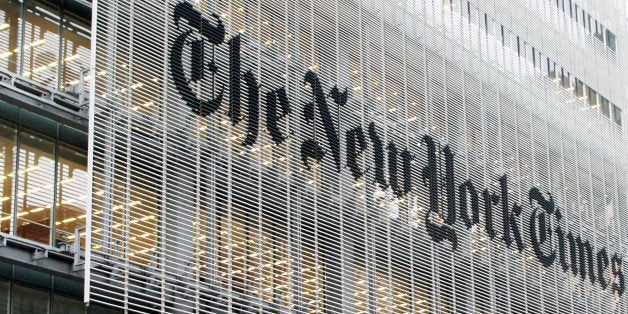
NEW YORK -- New York Times executive editor Dean Baquet announced changes Thursday to the paper's process of selecting stories for the front page of the print edition, a move that highlights the newspaper's continued digital transformation.
Baquet said in a staff memo that the changes "are intended to ensure that our digital platforms are much less tethered to print deadlines."
"We need to be posting more of our best stories not in the late evening, but when The Times’s digital readership is at its height: between 7 a.m. and 7 p.m," he wrote.
For many journalists working exclusively in digital media, it's hard to fully comprehend the importance of the next day's print edition. But within the Times, the front page has long been both a motivational tool and measure of success for reporters and editors.
A 2011 documentary on the Times grappling with the changing media landscape was titled "Page One," recognition of the outsized role that piece of print real estate has played in the newsroom. And even social media-savvy Times staffers routinely note on Twitter when their stories, or those of colleagues, appear on the print front page, or A1.
The Times' front page still carries influence, but the print edition no longer shapes the day's news agenda as it once did. Nowadays, plugged-in readers are consuming and sharing the paper's stories the afternoon or evening before they appear in print. Most online readers likely have no idea whether a Times story appeared on Page One or tucked inside the A section.
The Times took some steps last year to decrease the daily emphasis on the next morning's front page following the recommendation of an internal group focused on digital innovation. "The newsroom is unanimous: We are focusing too much time and energy on Page One," the report read. The revamped process announced Thursday continues on that trajectory.
In the memo, Baquet said Times desk editors would "pitch their best enterprise pieces for digital slots on what we’re calling Dean’s List." Each day, he wrote, the Times masthead editors would select which stories from this list "will receive the very best play on all our digital platforms -- web, mobile, social and others yet to come."
Baquet wrote that "the tradition of selecting Page 1 stories under the old system has long made The Times distinctive," and management intended "to preserve the rigor of this process, but update it for the digital age." Going forward, he wrote, the paper's various desks -- whether covering culture, business, politics or international news-- "will compete for the best digital, rather than print, real estate."
But the best digital real estate for reaching readers may not necessarily be a top slot on NYTimes.com. As Vox's Matt Yglesias pointed out on Twitter, the paper's own innovation report showed that visits to the Times homepage have dropped significantly in recent years.
"Our home page has been our main tool for getting our journalism to readers, but its impact is waning," the report noted. "Only a third of our readers ever visit it. And those who do visit are spending less time: page views and minutes spent per reader dropped by double-digit percentages last year."
While Baquet's changes are a step toward the paper's digital future, the Times isn't abandoning print. Just last night, the Times unveiled its relaunched weekend print magazine, the largest in the paper's history.
Baquet's full memo on changes to the Page One process is below:
All:
I’m excited to announce a small but significant step in our digital transformation.
Next week, we’re going to revamp the structure of our daily meetings and adopt a new system for pitching major enterprise.These changes are intended to ensure that our digital platforms are much less tethered to print deadlines. We need to be posting more of our best stories not in the late evening, but when The Times’s digital readership is at its height: between 7 a.m. and 7 p.m.
This new system will, in particular, give us more flexibility in targeting readers on mobile (which now receives more than half of our traffic) and on platforms like Facebook (where we are rolling out new strategies for presenting our journalism).
In short, our goal is to further elevate the primacy of our digital platforms in the daily life of the newsroom.Here are the changes:
• We’re retiring our system of pitching stories for the print Page 1.
• Desks will instead pitch their best enterprise pieces for digital slots on what we’re calling Dean’s List. (I didn’t come up with that name, but I like it!)
• Stories that the masthead selects for Dean’s List will receive the very best play on all our digital platforms – web, mobile, social and others yet to come.
• There will be two Dean’s Lists: one designated after the morning meeting, and one after the afternoon meeting. Each list will typically contain three or four enterprise pieces.
• In general, stories on the lists must be ready for posting shortly after the meeting. In other words, if a desk pitches an enterprise piece for the morning Dean’s List, it must be available for posting by noon or so.
• It’s worth noting that the tradition of selecting Page 1 stories under the old system has long made The Times distinctive. We are seeking to preserve the rigor of this process, but update it for the digital age. Desks will compete for the best digital, rather than print, real estate.
• Desks will continue to pitch news for major digital play at both meetings. Dean’s List slots do not include news – only enterprise.
• In fact, I want to emphasize that I believe that the meetings are an important venue for talking about how we are going to handle the major news of the day. We want to have a robust discussion about lines of coverage and about how our journalism will be presented on different platforms.
• We’ll still select stories for the print Page 1 at the afternoon meeting, but that process will play a less prominent role.I realize that it will take time for all of us to adjust to this new way of doing things. We’re going to follow up shortly with a memo to the desks about the details and logistics of the new system.
Still, you’ll undoubtedly have questions. Please feel free to reach out to me or other masthead editors.
Dean
